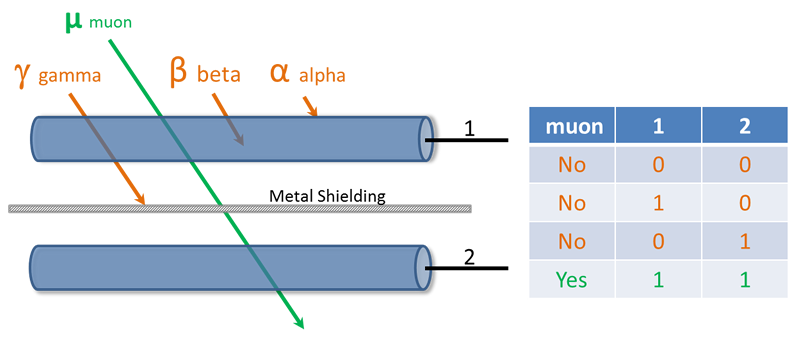-
1Considerations for building a cosmic ray detector
Cosmic Rays are created high in the earth's atmosphere (~30km) and the resulting shower of subatomic particles are what we can detect at sea level. These particles interact with atmosphere, decay or are difficult to detect, but the muon the heavier cousin of the electron can be detected as it has a charge and can ionise matter as it passes through. Consequently it can be detected using any ionising radiation detector such as: Cloud chambers, Electroscope, Geiger Counters, Spark Chambers, Resistive Plate Chambers, and materials called Scintillators which give off light when an ionizing particle passes through them.
A muon has a measured mean lifetime of 2.2 microseconds and should only be able to travel a distance of 660 metres even at near the speed of light and so should not be capable of reaching sea level. However, Einstein’s theory of relativity tells us that time ticks slowly when moving at speeds close to that of light. Whilst the mean lifetime of the muon at rest is only a few microseconds it moves at near the speed of light and so its lifetime is increased by a factor of ten or more giving them plenty of time to reach the ground and be detected.
The problem of using a radiation detector for a cosmic ray observations, is that there is larger amounts of terrestrial radiation as much 73% of background radiation is Alpha, Beta, and Gamma from the natural decay of matter. Although in small quantities it is sufficient to make it difficult to discriminate between a terrestrial or cosmic sources.
Consequently, at least two detectors are needed placed one above the other, feed into electronics that can monitor coincidence between the two detectors quickly thus, filtering out most terrestrial radiation.
![]()
Cosmic particles travel at nearly the speed of light and so do not ionise very efficiently and hence can travel through matter very easily passing through metal shielding and both detectors without effort, whereas the terrestrial radiation may not. Consequently anything detected in both detectors simultaneously is more likely to be a cosmic event than terrestrial.
Well almost simultaneously, if a muon is travelling at 0.998c and the detectors where spaced 5cm apart the actual flight time of a muon would be just 0.16ns. However as the detector and electronics response and delay times would be much slower than this, we can say in "real-life" terms it is simultaneous.
The main idea of coincidence detection in signal processing is that if a detector detects a signal pulse in the midst of random noise pulses inherent in the detector, there is a certain probability, p, that the detected pulse is actually a noise pulse. But if two detectors detect the signal pulse simultaneously, the probability that it is a noise pulse in the detectors is p2. Suppose p = 0.1. Then p2 = 0.01. Thus the chance of a false detection is reduced by the use of coincidence detection.
-
2Geiger–Müller Tubes
I've had comments regarding the validity of using Geiger–Müller Tubes for a cosmic ray (muon) detector. Pointing out that Photomultipliers and scintillation panels are best, and yes the are far more effective. However, they are also expensive, whereas Geiger–Müller tubes are relatively cheap and easily available to purchase.
History is full of examples of physicists using Geiger–Müller tubes for cosmic ray observations up to the 80s. Geiger Tube Telescopes (GTT) were used by NASA including many Pioneer spacecraft missions and others. One most notable user was Bruno Benedetto Rossi a famous Italian experimental physicist who made major contributions to particle physics and the study of cosmic rays. At the age of 24, he fabricated his own Cosmic Ray detector using Geiger–Müller tubes and then went on to invent the first practical electronic coincident circuit.
Cosmic Array
An array of cosmic ray detectors across a landscape that demonstrates in light and sound how cosmic rays are constantly all around us.
 Robert Hart
Robert Hart
Discussions
Become a Hackaday.io Member
Create an account to leave a comment. Already have an account? Log In.